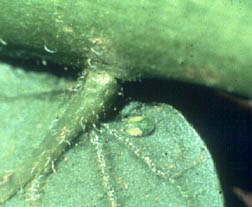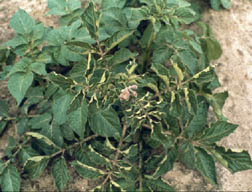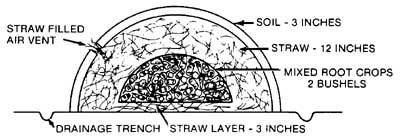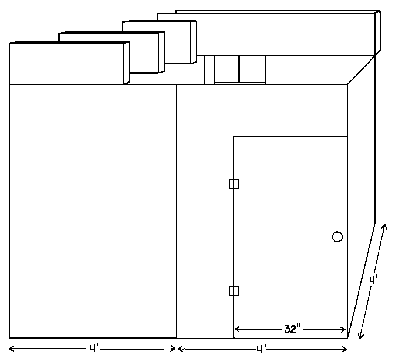Quick Facts...
- Potatoes provide 13 essential vitamins and minerals.
- Variety and tuber texture determine a potato's best use.
- Allow about 15 pounds of seed potatoes (2.5 ounces each) for each 100 feet of row.
- A 100 foot row can yield more than 200 pounds of potatoes.
- High quality, certified seed gives the best results.
- Maximum water use occurs during vine growth and early tuber bulking.
- Store potatoes in a dark, humid place at 38 to 45 degrees F.
Potato production can be an enjoyable and rewarding experience for the home Gardener. Few vegetables yield more food per square foot than the potato.
The average potato provides 40 percent of the recommended daily allowance for vitamin C, has 3 grams of protein, is an excellent source of dietary fiber, and furnishes 12 other essential vitamins and minerals -- all with no fat.
Variety Selection
Potatoes add diversity, versatility and convenience to menus. They can be boiled, baked, fried and prepared several other ways. Skin color does not determine a potato's use, its texture does. Potatoes that are high in starch or dry matter are more mealy. They tend to bake up nicely and make good fries and chips. Those low in starch are more waxy and often higher in sugar. These varieties hold together better during boiling and are best used for salads, soups and similar dishes.
Select varieties that suit both your culinary needs and your local growing conditions. Many early varieties provide "new" potatoes in early to mid-July. Later maturing varieties take about 100 days from emergence to produce a crop with an acceptable yield.
Table 1 provides information on adaptability of common varieties suited to Colorado's diverse climate. Culinary uses, along with strengths and weaknesses of the varieties, also are summarized.
Seed
It is possible to grow potatoes from true botanical seeds set in small berries on many potato plants (Figure 1). This is not a good practice, however. Each seed is genetically unique. Therefore, seeds cannot be used reliably to produce a uniform Garden crop.
Most home Gardeners, instead, get better results from whole tubers or cut seed pieces. This practice is called vegetative propagation. Whole tubers used for seed should weigh 2 ounces or more for best results. If using cut seed (pieces cut from larger tubers), each piece should have 2 to 3 eyes and weigh about 2.5 ounces. Use a sharp, clean knife to cut whole tubers into seed. A 10 percent solution of regular household bleach (1 ounce bleach to 9 ounces of water) makes an excellent dip for sterilizing the knife between cuts.
| Table 1: Popular potato varieties for the home Garden in Colorado. | ||||
| Variety | Description | Maturity1 | Use | Comments |
|---|---|---|---|---|
| All Blue | Long tuber type with blue-purple flesh color and dark blue-purple skin. High yielding. | Medium to late | Microwaving Salad Baking |
Exotic. |
| All Red | Oblong tuber type with light red flesh and skin color. Medium yielding. | Medium | Microwaving Salad Baking |
Exotic. |
| Chipeta | Round to oblong tuber type with white skin and creamy flesh. High yielding. | Late | Chipping Baking |
Developed in Colorado. Requires low fertility and water to produce very high yields. |
| Dark Red Norland | Round tuber type with bright red skin. Medium yielding. | Very early | Boiling Roasting Salad |
Popular Garden variety. Has some resistance to scab. |
| Kennebec | Oblong tuber type with white skin. High yielding. | Medium to late | Chipping | Occasional deep eyes can make peeling difficult. May become very large. |
| Norgold Russet | Oblong tuber type with medium russet skin and shallow eyes. Medium yielding. | Very early | Baking | Occasional hollow heart2. |
| Red LaSoda | Oval shape with light red skin. High yielding. | Late | Boiling Roasting Salad |
Wide adaptability. Deep eyes may make peeling difficult. Occasional growth cracks and hollow heart. |
| Russet Burbank | Long tuber type with medium russet skin. Medium to high yielding. | Late | Baking French fries |
Stores well. Somewhat difficult to grow in the home Garden. Susceptible to stress-induced diseases and misshapen tubers. |
| Russet Norkotah | Long tuber type with golden russet skin. Medium yielding. | Very early | Baking | Very attractive appearance. Well suited to production in the San Luis Valley. |
| Russet Nugget | Oblong to long tuber type with medium-heavy russet skin. Medium yielding. | Late | Baking French fries |
Developed in Colorado. Requires low fertility and water. Resistant to many diseases and quality disorders. |
| Sangre | Round tuber type with dark red skin. High yielding. | Medium | Baking Boiling Salad |
Developed in Colorado. May emerge erratically. Develops a slight net in some soils. Stores well and has excellent cooking quality. |
| Yellow Finn | Oblong tuber type with white skin and yellow flesh. Medium yielding. | Medium to late | Salad | Wide adaptability. An heirloom Garden variety. |
| Yukon Gold | Oblong tuber shape with buff skin and yellow flesh. High yielding. | Very early | Baking Mashing Roasting |
Attractive appearance and good flavor. Suitable for many culinary uses. |
| 1Maturity in days from emergence
(DAE): Early 65-85 DAE, Medium 85-100 DAE, Late more than 100
DAE. 2Hollow heart is a physiological condition resulting in a small lens-shaped area inside the tuber. This condition is triggered by erratic watering and high nitrogen fertility. | ||||
Plant cut seed immediately if soil conditions and temperature are ideal. Otherwise, heal them for 3 to 4 days in the dark at room temperature and high humidity. Do not expose cut seed to sun or allow it to dry out.
You need about 15 pounds of seed for each 100 feet of row. Obtaining seed potatoes often may be a problem for the home Gardener. Sources include local Garden centers and seed catalogs. Check with your local Colorado State University Cooperative Extension county office to be sure there are no restrictions on seed potatoes imported from out of state.
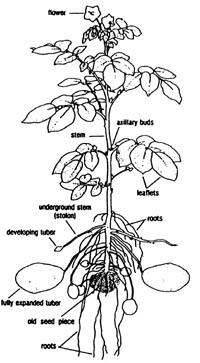 |
| Figure 1: Diagram of a potato plant. (Adapted from Commercial Potato Production in North America, Potato Association of America, Orono, Me., 1980, 36 pp.) |
Purchase only certified seed, as it has been inspected for disease and quality. Do not buy table stock potatoes in the produce section of your local grocery store. Most of them have been exposed to sprout inhibitors, which prevent the tubers from sprouting and forming a healthy plant. Do not save seed from the previous year -- it may be infected with seed-borne diseases.
When preparing seed for cutting or planting, warm it to 50 to 65 degrees to encourage germination and sprout growth. Tubers with sprouts 1/8 to 1/4 inch long are ideal. They should emerge rapidly under proper conditions. Do not wash seed tubers. This may increase disease susceptibility and disease spread between tubers.
Planting
Plant potatoes up to 2 weeks earlier than the average date of the last spring frost. The soil temperature should be 45 degrees or warmer. Potatoes prefer a sandy to sandy loam soil. Till the soil to a depth of 16 inches and pre-irrigate the soil until moist.
Commercial fertilizer may be used if desired. Place the fertilizer in a band about 6 to 7 inches deep and to the side of where the seed will lie in the bed. Do not put fertilizer in direct contact with the seed, as this may damage it. Potatoes use approximately 0.38 pounds of nitrogen for each 100 square feet of Garden space.
Use a complete fertilizer like 20-20-20; i.e., the fertilizer contains 20 percent nitrogen, 20 percent phosphorus and 20 percent potassium. For example, for a 100 square foot area, apply 1.9 pounds of fertilizer to achieve the proper fertilizer rate (0.38 lbs. N per 100 square feet / 0.20 N per pound of fertilizer = 1.9 pounds for a 100 square foot area). Levels of soil fertility and fertilizer needs are best obtained by soil sampling. See fact sheet 0.500, Soil Sampling, for information on how to take a soil sample.
Some Gardeners find that applying half of the fertilizer at planting and the other half in late June works best. If plants appear to be yellowing at midseason, apply nitrogen to the sides of the hills or add it with the irrigation water. Be careful not to apply too much nitrogen. This may delay tuber development and decrease yield.
Some Gardeners prefer to use manure. If manure is applied, do it the year before planting potatoes. Make sure it is well aged to prevent burning and the possible introduction of diseases and weeds. Manure also promotes common scab on new tubers.
Plant potatoes in rows 30 to 36 inches apart. Space seed pieces within the row at 10 to 12 inches at a depth of about 4 inches. Hills may be formed at the time of planting or in the following four weeks. Hilling provides more space for the developing tubers to grow and helps prevent green potatoes.
It is a good idea to rotate spots in the Garden for potato production. Planting in the same area year after year may lead to disease and insect problems.
 |
| Figure 2: Growth stages of the potato plant. I: Vegetative Growth: sprouts emerge and form vegetative leaves. II: Tuber Initiation: tubers begin to form on stolons, foliage continues to develop. III: Tuber Growth: tuber enlargement. IV: Maturation: tuber skin thickens, vines begin to senesce. (Adapted from Integrated Pest Management for Potatoes in the Western United States, University of California, Division of Agriculture and Natural Resources Publication 3316, Oakland, CA, 1986, 146 pp.) |
Irrigation
Keep soil moist but not wet. Potatoes require abundant oxygen and do not flourish in compacted soils. Generally, potatoes have a shallow root system. Most moisture is taken up from the top foot of soil. Be particularly careful to avoid overwatering during the first weeks after planting.
After plants have emerged, irrigate every three to five days, thoroughly wetting the soil to a depth of about 2 feet. Do not subject potato plants to water stress, as this will result in lower yield and misshapen tubers. Water stress is indicated by wilting and a dark gray-green hue to the foliage. Leaflets may roll slightly.
Maximum water use occurs during vine growth and early tuber development. To prevent the maturing tubers from being predisposed to rot organisms, reduce watering when vine death begins.
Pest Control
In the home Garden, weeds are most easily controlled by hoeing, pulling and light cultivation before the plants reach 8 to 10 inches tall. Avoid cultivation after this stage, as root damage may occur which will reduce yield. Weeds compete with potato plants for light, water and nutrients. After the plants reach 8 to 10 inches tall, they are better able to compete with the weeds.
The most common weeds in potatoes are red root pigweed, kochia, lambsquarter and nightshade. If thistle or quackgrass become a problem, consult your Colorado State Cooperative Extension county office or Garden supply store for information regarding the proper herbicide to apply.
Treat insect pests with insecticides or, for those preferring organic controls, with insecticidal soaps. Common Insects in Colorado home Gardens include aphids, flea beetles, psyllids and, in some areas, Colorado potato beetles.
Potato diseases may be seed-borne or acquired during the growing season. Many diseases can be avoided by using certified seed. Remove plants that are small, yellowing and sickly. Commonly encountered diseases in the Garden include scab, early blight, pink rot and black scurf.
Scab is caused by a bacterium. It is characterized by small, brown lesions on the tuber skin, seen at harvest. Scab development is enhanced by dry conditions and soils high in organic matter or recently amended with manure. Scab does not affect tuber quality, only appearance. Rotate the location of potatoes in the Garden to reduce the incidence of scab.
Early blight is characterized by small, target-shaped lesions on the foliage. Lesions begin on lower, mature leaves. It is caused by a fungus. Proper soil moisture and fertility levels can prevent or minimize its incidence, because stressed plants are more susceptible. A fungicide treatment every 14 days will help control this disease. Early blight tuber decay rarely occurs in home Gardens if tubers are harvested gently, vines are completely dead prior to harvest, and skins are adequately set.
Swollen, waterlogged tubers that may be partially or totally rotted are characteristic of pink rot. Proper water management late in the season is the best control for this fungal disease.
Black scurf on the tuber surface is frequently referred to as the "dirt that won't wash off." This fungal disease manifests itself on tubers if they lie in the soil for a long time after vine death. The best control is to plant seed that is free of black scurf.
Read and carefully follow all label directions when using pesticides.
Harvest and Storage
Potato plants mature and begin to die about 70 to 100 days after planting, depending upon variety. As plants mature, they use less water. To promote skin set, leave tubers in the ground for 10 to 21 days following vine death. This decreases bruising during harvest and permits better storage. Harvest when the soil temperature is 50 to 65 degrees.
"New potatoes," on the other hand, are harvested earlier, when vines are still lush and green. Skins of these small tubers are fragile and the tubers quickly dry out if they are not used immediately or refrigerated.
Store potatoes in a cool, dark and humid place. Air circulation through the pile of potatoes is desirable. Potato tubers are living, breathing vegetables. Storage sites are not potato "hospitals" but rather "hotels." Potato quality does not improve with storage.
Proper care at harvest can prevent many storage related problems. Cure the tubers at 50 to 60 degrees for two to three weeks, then cool to the desired storage temperature. Most Gardeners store their crop at 38 to 45 degrees and 90 percent or higher humidity. Do not allow condensation to form on tuber surfaces -- it may lead to rot problems.
Tubers stored in this manner will not sprout for approximately three months. Significant variation in either temperature (above 50 to 65 degrees or below 30 to 37 degrees) or humidity (below 75 percent) during storage will decrease potato quality and often result in earlier sprouting.
Do not store potatoes with fruit. Apples, for instance, give off a growth-regulating gas, ethylene, which promotes sprouting of potato tubers.
Do not eat green tubers. Instead, cut away green areas and discard. These areas contain glycoalkaloids, which impart a bitter taste and can give you a stomach ache.

